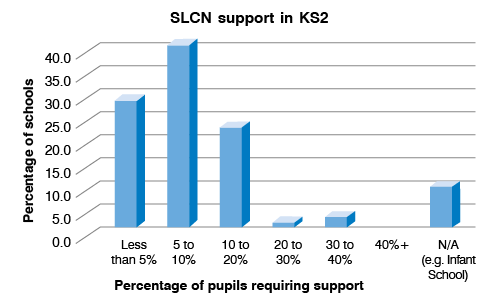In the autumn issue of the magazine, we launched The Link Survey to hear what you had to say about your experience of SLCN support.
As promised, in this issue of The Link we’re reviewing the responses to The Link Survey we’ve received. Thank you for taking the time to contribute, your thoughts have been really interesting.
The schools
Most of the schools, 87%, were primary or infant. 7% of schools had fewer than 100 pupils, 70% between 100 and 400 and the remaining 23% had more than 400 pupils. The respondent from each school was usually a SENCo or teacher.
EAL numbers
51% of schools reported less than 5% of pupils with English as an Additional Language (EAL), with 32% having 5 to 30% EAL, and 17% of schools having more than 30% EAL.
Children receiving any type of support for SLCN


It’s interesting to note that, while there is a shift towards fewer pupils requiring support in KS2, there is still a significant proportion of pupils in KS2 who require support for SLCN. This indicates a clear need for SLCN support throughout pupils’ time in school.
Funding
When ranking overall funding for SLCN on a scale of 1 to 7 with 1 representing “Little or no funding”, 75% of schools gave a score of 3 or less.
However, schools were split roughly 50:50 as to whether they ever used pupil premium for SLCN support 52% “Yes”, 48% “No”.
When the use of Covid-19 catch-up funding was considered 46% said they planned to use this funding for SLCN related issues.

Effect of the pandemic
82% of schools felt the incidence of SLCN had increased during the pandemic with 16% being unsure. The remaining 2% of schools felt that the pandemic had not affected the incidence of SLCN.
Our own evidence from Language Link assessments carried out during autumn 2020 indicates a 20% increase in pupils recording the lowest levels of language skills.
Identifying SLCN
55% of schools felt that a lack of staffing and budgetary constraints were the biggest obstacles to fully identifying pupils with SLCN. Despite these obstacles our speech and language therapy team comment that it is usually not possible to identify SLCN by observation alone, which means that it’s really important that schools have access to objective tools for identifying pupils’ needs, such as the Language Link screening assessments.
Supporting SLCN
Schools were asked whether their LA provided any support beyond that given for pupils with statutory support, such as an EHCP. Approximately 44% said “No”, 41% had some level of support and the remaining schools were unsure or found support very difficult to access.
Most schools were confident they knew when to involve outside agencies for a child with SLCN. On a scale of 1 to 7 from “Never entirely sure” to “Always certain” 72% responded with 5 or above.
It is encouraging that many schools have confidence that they know when to access support from outside agencies. However, our therapy team comment that this may be because this support can only be accessed in the most severe cases, given the large proportion of schools that feel there is no support from their LA beyond the statutory level.
When asked what currently restricts your ability to support pupils’ SLCN in school, the answers given in the pie chart below were selected. Respondents could select more than one option.
When asked if they believed school-based SLCN interventions are effective from 1 (often effective) to 7 (rarely effective), 84% gave a response from 1 to 3, showing most respondents felt such interventions are effective.
Just over 80% of schools used one or more in-school support package, such as Speech Link and Language Link.
Finally, 63% of respondents had undertaken face to face or online training in supporting SLCN.

![]()
Congratulations to Mottram CofE Primary, Tameside and a lucky Derbyshire school. Both are winners of our free prize draw for a year’s subscription to all the Speech and Language Link support packages. Thank you for taking part in The Link Survey!
Please login to view this content
Login